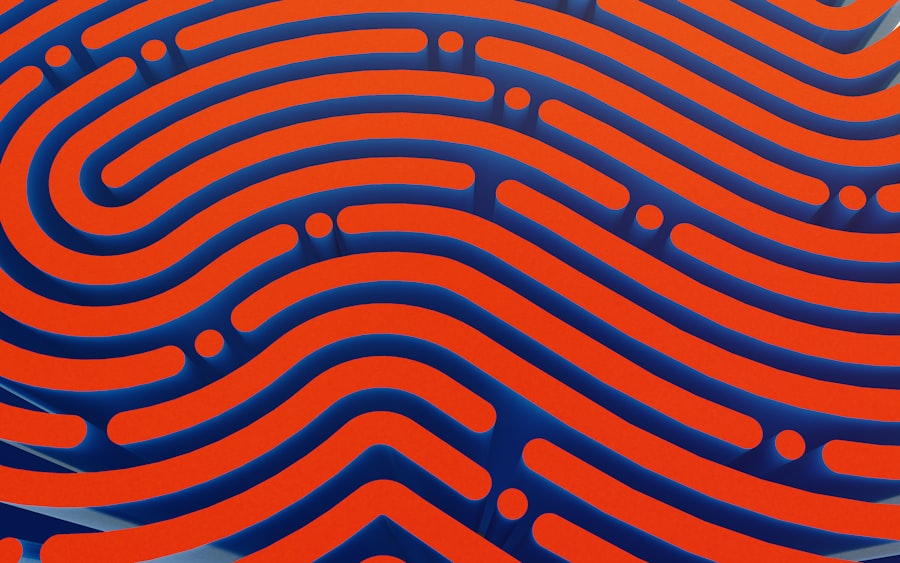Biometric authentication has emerged as a pivotal technology in the realm of security, offering a sophisticated alternative to traditional methods such as passwords and PINs. By leveraging unique biological traits, biometric systems provide a means of verifying identity that is both secure and user-friendly. The increasing reliance on digital platforms for personal and professional activities has heightened the need for robust security measures, making biometric authentication an attractive solution.
This technology encompasses various modalities, including fingerprint recognition, facial recognition, iris scanning, voice recognition, and behavioral biometrics, each with its own set of advantages and applications. As cyber threats continue to evolve, the demand for more secure authentication methods has propelled biometric technology into the spotlight. The appeal of biometric authentication lies in its ability to offer a higher level of security while enhancing user convenience.
Unlike traditional authentication methods that rely on something the user knows (like a password) or possesses (like a security token), biometrics are inherently tied to the individual. This intrinsic connection makes it significantly more difficult for unauthorized users to gain access to sensitive information or systems. Furthermore, as technology advances, biometric systems are becoming increasingly sophisticated, incorporating machine learning and artificial intelligence to improve accuracy and reduce false positives.
As we delve deeper into the various types of biometric authentication, it becomes clear that this technology is not just a trend but a fundamental shift in how we approach security in an increasingly digital world.
Key Takeaways
- Biometric authentication uses unique physical or behavioral characteristics to verify a person’s identity.
- Fingerprint authentication works by capturing and analyzing the unique patterns of ridges and valleys on a person’s fingertip.
- Face ID authentication uses facial recognition technology to map and analyze unique facial features for identity verification.
- Iris recognition technology uses the unique patterns in a person’s iris to verify their identity, offering a high level of accuracy.
- Voice recognition and authentication uses the unique characteristics of a person’s voice, such as pitch and tone, to verify their identity.
How Fingerprint Authentication Works
How Fingerprint Authentication Works
The process of fingerprint authentication begins with the capture of an individual’s fingerprint using a scanner or sensor, which can be optical, capacitive, or ultrasonic in nature. Optical scanners capture an image of the fingerprint by illuminating it with light, while capacitive scanners use electrical currents to map the ridges and valleys of the fingerprint. Ultrasonic scanners, on the other hand, utilize high-frequency sound waves to create a detailed 3D image of the fingerprint.
Fingerprint Data Processing and Storage
Once captured, the fingerprint data is processed to extract unique features such as ridge endings and bifurcations, which are then converted into a mathematical representation known as a template. After the template is created, it is stored in a secure database for future comparisons.
Authentication and Limitations
When an individual attempts to authenticate their identity by placing their finger on the scanner again, the system captures a new fingerprint image and generates a new template. This new template is then compared against the stored template using algorithms designed to measure similarity. If the match exceeds a predetermined threshold, access is granted; if not, the authentication fails. While fingerprint recognition is generally reliable, it is not infallible; factors such as dirt, moisture, or skin conditions can affect the quality of the scan and potentially lead to false rejections.
Understanding Face ID Authentication

Face ID authentication represents a significant advancement in biometric technology, utilizing facial recognition to verify identity. This method relies on sophisticated algorithms that analyze facial features such as the distance between the eyes, the shape of the jawline, and other unique characteristics. The process begins with capturing an image of the user’s face through a camera equipped with infrared sensors and depth-sensing technology.
This allows for a three-dimensional mapping of the face, which enhances accuracy by accounting for variations in lighting and angles. Once captured, the facial data is processed to create a unique template that serves as a reference for future comparisons. When an individual attempts to unlock their device or gain access to a secure area using Face ID, the system captures another image of their face and compares it against the stored template.
Advanced algorithms assess various facial landmarks to determine if there is a match. The speed at which this process occurs is remarkable; typically, it takes less than a second for the system to authenticate the user. One of the key advantages of Face ID is its convenience; users can unlock their devices simply by looking at them without needing to touch any buttons or enter passwords.
However, concerns regarding privacy and security have arisen, particularly regarding how facial data is stored and used. Additionally, while Face ID is generally reliable, it may struggle with accuracy in certain conditions, such as when users wear masks or have significant changes in appearance.
Exploring Iris Recognition Technology
Iris recognition technology offers another layer of biometric authentication that is both highly secure and unique to each individual. The iris—the colored part of the eye—contains intricate patterns that are formed during fetal development and remain stable throughout a person’s life. This stability makes iris recognition an exceptionally reliable method for identifying individuals.
The process begins with capturing an image of the iris using specialized cameras equipped with infrared illumination. This technique allows for high-resolution images that reveal the unique patterns within the iris while minimizing interference from reflections or ambient light. Once an image is captured, sophisticated algorithms analyze the iris patterns and convert them into a mathematical representation known as an iris code.
This code is then stored in a secure database for future reference. When an individual seeks authentication, their iris is scanned again, and a new iris code is generated for comparison against the stored code. The accuracy of iris recognition is remarkable; studies have shown that it boasts one of the lowest false acceptance rates among biometric modalities.
However, despite its high level of security, iris recognition systems can be more expensive and complex to implement compared to other biometric methods. Additionally, factors such as eye conditions or obstructions can affect performance, necessitating careful consideration when deploying this technology in various environments.
Voice Recognition and Authentication
Voice recognition technology has gained traction as a viable form of biometric authentication due to its accessibility and ease of use. This method relies on analyzing unique vocal characteristics such as pitch, tone, cadence, and speech patterns to verify identity. The process begins with capturing a sample of an individual’s voice through a microphone or voice recognition system.
Advanced algorithms then analyze various features of the voice sample to create a unique voiceprint—a digital representation that encapsulates the distinctive qualities of an individual’s speech. When authentication is required, the system captures another voice sample from the user and compares it against the stored voiceprint. The algorithms assess similarities between the two samples to determine if they match within acceptable parameters.
One of the primary advantages of voice recognition is its hands-free nature; users can authenticate themselves simply by speaking commands or phrases without needing physical interaction with devices. However, challenges remain in terms of accuracy; background noise or changes in vocal quality due to illness or emotional state can impact performance. Additionally, concerns about spoofing—where an unauthorized user mimics another person’s voice—have prompted ongoing research into enhancing security measures within voice recognition systems.
Behavioral Biometrics: How it Works

How it Works
The process begins with data collection, where behavioral biometrics systems gather information about how users interact with their devices during regular use. Machine learning algorithms then analyze this data to identify distinct patterns that characterize each user’s behavior. When an individual attempts to access a system or application, their current behavior is compared against their established profile in real-time.
Authentication and Security
If discrepancies are detected, such as unusual typing speed or erratic mouse movements, the system may trigger additional security measures or deny access altogether. One of the key advantages of behavioral biometrics is its ability to provide continuous authentication; users remain authenticated as long as their behavior aligns with their established patterns.
Challenges and Limitations
However, challenges exist in terms of privacy concerns and potential false positives due to changes in behavior caused by external factors such as stress or fatigue.
Advantages and Limitations of Biometric Authentication
Biometric authentication offers numerous advantages that make it an appealing choice for securing sensitive information and systems. One of its most significant benefits is enhanced security; because biometric traits are unique to each individual, they are much harder to replicate or steal compared to traditional passwords or tokens. This intrinsic uniqueness reduces the risk of unauthorized access significantly.
Additionally, biometric systems often provide greater convenience for users; they eliminate the need for remembering complex passwords or carrying physical tokens since authentication can occur quickly through natural actions like touching a fingerprint scanner or looking at a camera. However, despite these advantages, biometric authentication also has limitations that must be considered. One major concern revolves around privacy; individuals may be apprehensive about how their biometric data is collected, stored, and used by organizations.
Data breaches involving biometric information can have severe consequences since unlike passwords, biometric traits cannot be changed if compromised. Furthermore, while biometric systems are generally reliable, they are not infallible; factors such as environmental conditions or physical changes can affect performance and lead to false rejections or acceptances. As organizations increasingly adopt biometric technologies, striking a balance between security and privacy will be crucial in ensuring user trust and acceptance.
Future of Biometric Authentication Technology
The future of biometric authentication technology appears promising as advancements continue to reshape how we approach identity verification in an increasingly digital landscape. Emerging trends indicate that integration with artificial intelligence (AI) will play a pivotal role in enhancing accuracy and efficiency across various biometric modalities. AI algorithms can analyze vast amounts of data from multiple sources—such as facial recognition combined with behavioral biometrics—to create more comprehensive profiles that improve security while minimizing false positives and negatives.
Moreover, as concerns about privacy persist, there is likely to be a growing emphasis on developing ethical frameworks surrounding biometric data collection and usage. Organizations will need to prioritize transparency regarding how they handle biometric information while implementing robust security measures to protect against breaches. Additionally, innovations such as decentralized storage solutions may emerge as viable alternatives to traditional centralized databases, allowing individuals greater control over their own biometric data while still enabling secure authentication processes.
As these technologies evolve alongside societal expectations regarding privacy and security, biometric authentication will undoubtedly continue to play an integral role in shaping our digital interactions for years to come.
If you’re interested in the latest technology for graphic design, particularly in terms of hardware that supports advanced security features like biometric authentication, you might want to check out this article on the best laptops for graphic design in 2023. It provides a comprehensive review of top laptops that are not only powerful in terms of performance but also come equipped with modern security features such as fingerprint readers and facial recognition, ensuring that your work and personal data remain secure.
FAQs
What is biometric authentication?
Biometric authentication is a security process that uses unique physical or behavioral characteristics, such as fingerprints, face recognition, or iris scans, to verify a person’s identity.
How does fingerprint authentication work?
Fingerprint authentication works by capturing an image of a person’s fingerprint and then comparing it to a stored template to verify their identity. This process can be done using a fingerprint scanner or sensor.
What is face ID authentication?
Face ID authentication uses facial recognition technology to map and analyze the unique features of a person’s face, such as the distance between their eyes and the shape of their nose, to verify their identity.
How does iris scanning authentication work?
Iris scanning authentication works by capturing a high-resolution image of a person’s iris and then using pattern recognition algorithms to compare it to a stored template for identity verification.
What are the advantages of biometric authentication?
Biometric authentication offers advantages such as increased security, convenience, and accuracy compared to traditional methods like passwords or PINs. It also reduces the risk of identity theft and fraud.
Are there any limitations to biometric authentication?
Some limitations of biometric authentication include potential privacy concerns, the need for specialized hardware, and the possibility of false positives or false negatives in the identification process.

